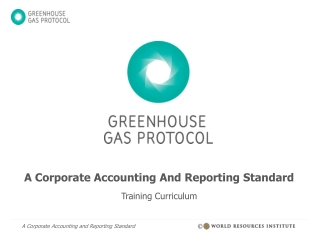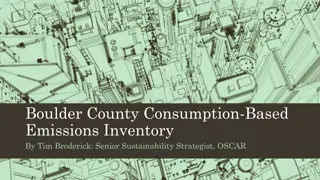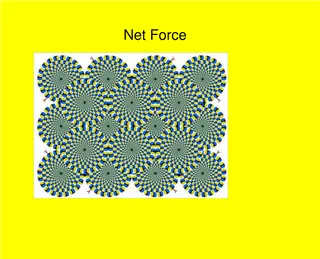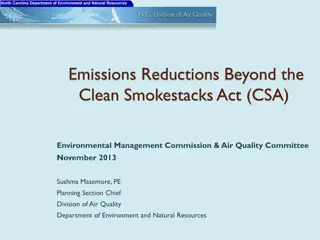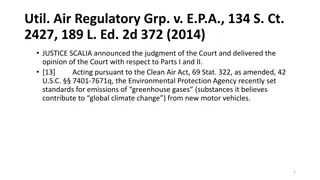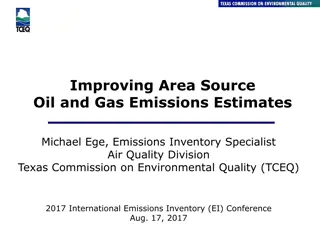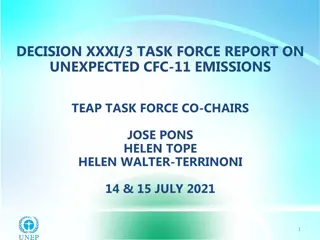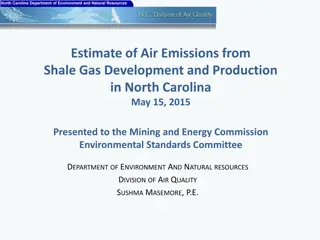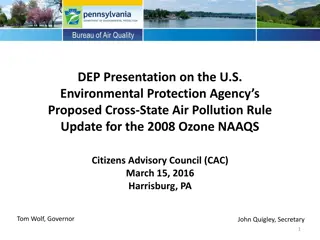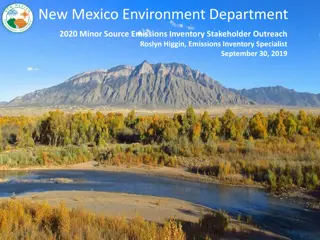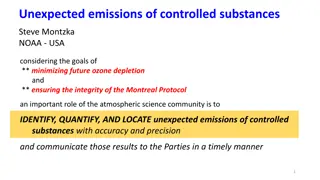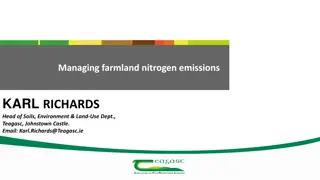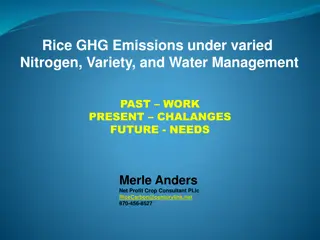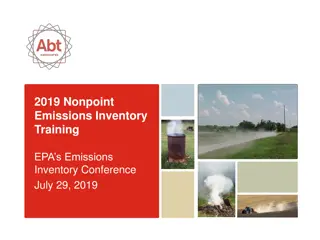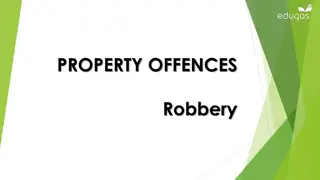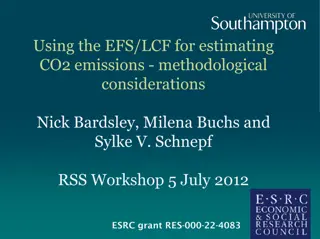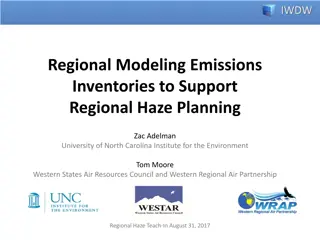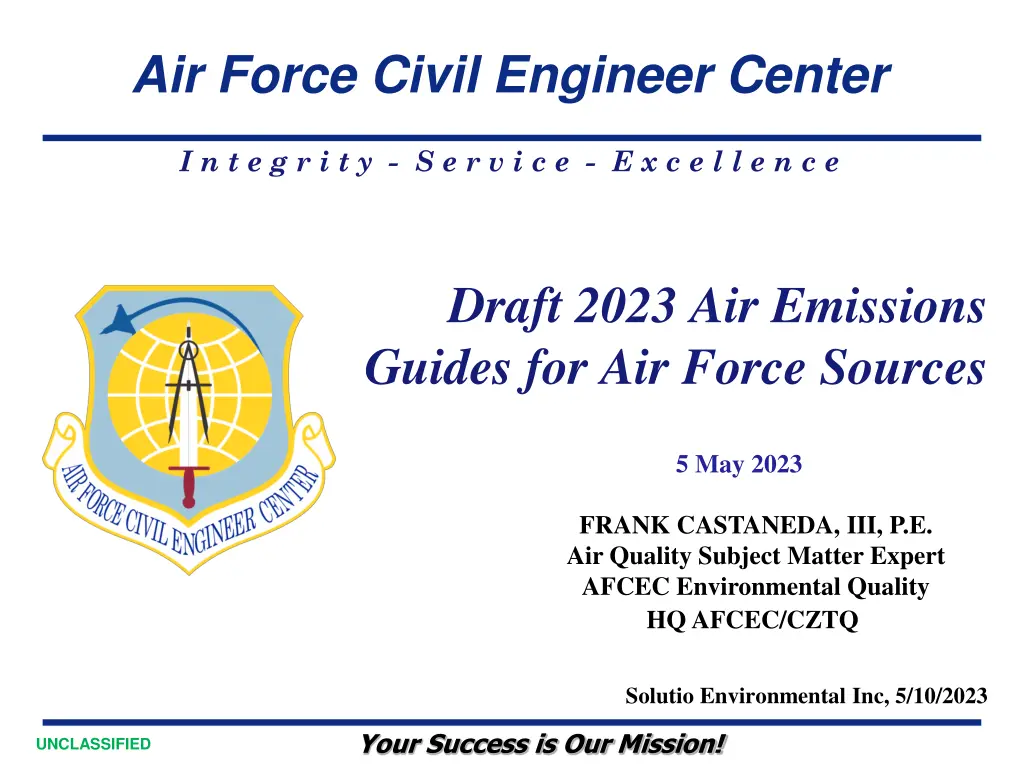
Draft 2023 Air Emissions Guides for Air Force Sources Overview
Explore the Draft 2023 Air Emissions Guides for Air Force Sources, including major revisions and where to download specific guides. Learn about the review process and key changes in the Stationary Guide chapters. Your input is crucial for the success of these guides.
Download Presentation

Please find below an Image/Link to download the presentation.
The content on the website is provided AS IS for your information and personal use only. It may not be sold, licensed, or shared on other websites without obtaining consent from the author. If you encounter any issues during the download, it is possible that the publisher has removed the file from their server.
You are allowed to download the files provided on this website for personal or commercial use, subject to the condition that they are used lawfully. All files are the property of their respective owners.
The content on the website is provided AS IS for your information and personal use only. It may not be sold, licensed, or shared on other websites without obtaining consent from the author.
E N D
Presentation Transcript
Air Force Civil Engineer Center I n t e g r i t y - S e r v i c e - E x c e l l e n c e Draft 2023 Air Emissions Guides for Air Force Sources 5 May 2023 FRANK CASTANEDA, III, P.E. Air Quality Subject Matter Expert AFCEC Environmental Quality HQ AFCEC/CZTQ Solutio Environmental Inc, 5/10/2023 Your Success is Our Mission! UNCLASSIFIED
Purpose Provide an overview of the major revisions/changes captured in the Draft 2023 Air Emissions Guides for Air Force Sources Your Success is Our Mission! 2
Where to Get the Draft Guides Each individual guide has a dedicated download link and response email address: Air Emissions Guide for Air Force Stationary Sources Download at: https://aqhelp.com/Stationary2023/ Send completed comment matrix to: Stationary2023@aqhelp.com Air Emissions Guide for Air Force Mobile Sources Download at: https://aqhelp.com/Mobile2023/ Send completed comment matrix to: Mobile2023@aqhelp.com Air Emissions Guide for Air Force Transitory Sources Download at: https://aqhelp.com/Transitory2023/ Send completed comment matrix to: Transitory2023@aqhelp.com Your Success is Our Mission! 3
Review Process When you open one of the dedicated download links you will be able to download the draft guide and associated comment matrix All comments must be submitted in the dedicated comment matrix, no other format will be accepted due to time constraints Upon completion of your comments on a specific guide, email your comment matrix to the dedicated email address for that guide All Comments due NLT 19 May 2023 Your Success is Our Mission! 4
Stationary Guide Your Success is Our Mission!
Stationary Guide Ch. 1 - Introduction REVISED: Criteria Pollutant Corrections: Sulfur Dioxide (SO2) to Sulfur Oxide (SOx) o Regulated as Sulfur Dioxide (SO2) Nitrogen Dioxide (NO2) to Nitrogen Oxide (NOx) o Regulated as Nitrogen Dioxide (NO2) Note that the EPA generally gets this wrong in their websites and documents Your Success is Our Mission! 6
Stationary Guide All Chapters NEW: Speciated GHG EFs to all sources Carbon dioxide (CO2) Methane (CH4), and Nitrogen dioxide (N2O) CO2 equivalents (CO2e), based on Global Warming Potentials (GWP) CO2e = (CO2 x 1 GWP) + (CH4 x 25 GWP) + (N2O x 298 GWP) Your Success is Our Mission! 7
Stationary Guide All Chapters Speciated GHG EFs added to the following: Ch. 2 External Combustion (ECOM) o Table 2-4. GHG Emission Factors for Natural Gas-Fired ECOM Units o Table 2-7. GHG Emission Factors for Fuel Oil-Fired ECOM Units o Table 2-10. GHG Emission Factors for Bituminous/ Subbituminous Coal-Fired ECOM o Table 2-13. GHG Emission Factors for LPG-Fired ECOM Units o Table 2-16. GHG Emission Factors for Waste Oil-Fired ECOM Units o Table 2-19. GHG Emission Factors for Digester Gas Flares (Enclosed) Ch. 3 Internal Combustion (ICOM) o Table 3-6. GHG Emission Factors for Stationary Compression Ignition ICOM Engines o Table 3-9. GHG Emission Factors for Stationary Spark Ignition ICOM Engines o Table 3-12. GHG Emission Factors for Stationary Turbine ICOM Engines Your Success is Our Mission! 8
Stationary Guide All Chapters Speciated GHG EFs added to the following: Ch. 12 Fire Fighter Training (FIRE) o Table 12-2. GHG Emission Factors for Burned Fuel During Fire Fighter Training o Table 12-4. GHG Emission Factors for Burned Materials During Fire Fighter Training Ch. 14 Incinerators o Table 14-2. GHG Emission Factors for Classified Waste Incinerators o Table 14-4. GHG Emission Factors for Medical Waste Incinerators Ch. 16 Munitions OB/OD o Table 16-2. GHG Emission Factors for Open Burn/Open Detonation Ch. 19 Small Arms Firing Range o Table 19-2. GHG Emission Factors for Cartridges Used at Small Arms Firing Ranges Ch. 20 Static Rocket Engine Testing o Table 20-2. GHG Emission Factors for Rocket Engine Testing Your Success is Our Mission! 9
Stationary Guide Ch. 35 Site Remediation REVISED: Site Remediation Expand discussion on rescinding exemptions from CAA o Resource Conservation and Recovery Act (RCRA) exemption o Comprehensive Environmental Response, Compensation, and Liability Act (CERCLA) Stationary vs Transitory Source? o Current Guide Exempt source under RCRA/CERCLA; therefore, USAF did not consider this a stationary source of emissions o Revised Guide For Major Sources of HAPs only, NESHAP removes RCRA/CERCLA exemption Your Success is Our Mission! 10
Mobile Guide Your Success is Our Mission!
Mobile Guide All Chapters NEW: Speciated GHG EFs to all sources Carbon dioxide (CO2) Methane (CH4), and Nitrogen dioxide (N2O) CO2 equivalents (CO2e), based on Global Warming Potentials (GWP) CO2e = (CO2 x 1 GWP) + (CH4 x 25 GWP) + (N2O x 298 GWP) Your Success is Our Mission! 12
Mobile Guide Ch. 1 Introduction REVISED: Criteria Pollutant Corrections: Revised definition of VOCs to reflect definition in 40 CFR 51.100 Sulfur Dioxide (SO2) to Sulfur Oxide (SOx) o Regulated as Sulfur Dioxide (SO2) Nitrogen Dioxide (NO2) to Nitrogen Oxide (NOx) o Regulated as Nitrogen Dioxide (NO2) Note that the EPA generally gets this wrong in their websites and documents Your Success is Our Mission! 13
Mobile Guide Ch. 2 Aircraft Flight Operations NEW: Total rewrite of chapter Most extensive revision of the guide NEW: Separated Aircraft Flight Operations by aircraft type: Fixed-Wing Aircraft: Also known as planes, are heavier-than-air flying machines that are capable of flight by using wings to generate lift via the aircraft s forward airspeed and the shape of the wings Rotary Aircraft: Also known as helicopters, are heavier-than-air flying machines that use rotary wings or blades to generate lift Your Success is Our Mission! 14
Mobile Guide Ch. 2 Aircraft Flight Operations REVISED: Mixing Height Under the EPA procedures: o A criteria pollutant emissions inventory for aircraft operations focuses only on pollutants emitted in the vertical column of air referred to as the mixing zone o Mixing zone is the lower atmospheric layer where air pollutant chemical reactions occur and above which there is a negligible effect on ground-level air pollution o Default mixing zone height (mixing height) defined by the EPA is 3,000 ft AGL Greenhouse Gasses (GHGs) o Unlike criteria pollutants, the impact of GHGs is at global-scale o GHGs chemical reactions occur below and above the mixing height o Given the mixing height is only associated with microscale criteria pollutant modeling, use of the mixing height for GHG modelling could be inadequate o While the mixing height constraint does not account for all GHGs, it does establish a fixed and consistent reference point for calculating emissions that can be used in a relative comparison analysis amongst alternatives Your Success is Our Mission! 15
Mobile Guide Ch. 2 Aircraft Flight Operations NEW: Region of Influence (ROI) There may be more than one ROI due to the physical and spatial distribution of the emissions sources associated with the proposed action Your Success is Our Mission! 16
Mobile Guide Ch. 2 Aircraft Flight Operations NEW: Three basic Flight Cycles for both fixed-wing and rotary aircraft: Landing and Takeoff (LTO) Cycle: A flight operation consisting of one complete repetitive takeoff and landing cycle. Low Flight Pattern (LFP) Cycle: A flight operation consisting of one complete repetitive flight cycle below the mixing height that does not include any part of a LTO or CP cycle. Closed Pattern (CP) Cycle: A flight operation consisting of one complete repetitive flight maneuver that involves practice landing on a runway by briefly touching the landing gear to the runway, or coming very close, and transitioning immediately into climb out and associated flying to maneuver into another practice landing Your Success is Our Mission! 17
Mobile Guide Ch. 2 Aircraft Flight Operations NEW: Rotary (Helicopter) Aircraft Flight Operations: Totally new modeling methodology Rotary aircraft flight patterns are described in terms of flying phase rather than flight modes (as with fixed-wing aircraft). Your Success is Our Mission! 18
Mobile Guide Ch. 2 Aircraft Flight Operations REVISED: Various other revisions: Table 2-3, Speciated GHG EFs o New speciated GHG EFs table for Jet Fuel and AVGAS Table 2-5, Default TIM Table o Update with new AF- collected data o Combined Taxi-in and Taxi-out columns o Removed Rotary category from Table (no defaults for rotary) Criteria Pollutant EF Table o Separated into two tables: Fixed-Wing Table and Rotary Table o Corrected EF for aircraft using AVGAS Your Success is Our Mission! 19
Mobile Guide Changes REVISED: Ch. 4 Non-Road Engines and Equipment Updated tables to reflect new data from Nonroad (MOVES and EMFAC) o Tables 4-1 to 4-5, Criteria Pollutant EFs for Non-Road Engines and Equipment o New EF for CY 2023 - 2027 REVISED: Ch. 5 On-Road Vehicles Updated Typical Air Force Vehicle Mix o Table 5-2, Typical Air Force POV & GOV Mix o Table 5-3, GOV Tactical and Non-Tactical Vehicle Mix Updated tables to reflect new data from MOVES and EMFAC o Tables 5-9 to 5-17, On-Road Vehicle Composite EFs (MOVES) o Table 5-18 to 5-24, On-Road Vehicle EFs (MOVES) o Table 5-23 to 5-30, On-Road Vehicle Composite EFs (EMFAC) o Table 5-31 to 5-34, On-Road Vehicle EFs (EMFAC) Your Success is Our Mission! 20
Transitory Guide Your Success is Our Mission!
Transitory Guide All Chapters NEW: Speciated GHG EFs to all sources Carbon dioxide (CO2) Methane (CH4), and Nitrogen dioxide (N2O) CO2 equivalents (CO2e), based on Global Warming Potentials (GWP) CO2e = (CO2 x 1 GWP) + (CH4 x 25 GWP) + (N2O x 298 GWP) Your Success is Our Mission! 22
Transitory Guide Ch. 1 Introduction REVISED: Criteria Pollutant Corrections: Revised definition of VOCs to reflect definition in 40 CFR 51.100 Sulfur Dioxide (SO2) to Sulfur Oxide (SOx) o Regulated as Sulfur Dioxide (SO2) Nitrogen Dioxide (NO2) to Nitrogen Oxide (NOx) o Regulated as Nitrogen Dioxide (NO2) Note that the EPA generally gets this wrong in their websites and documents Your Success is Our Mission! 23
Transitory Guide Ch. 3 Burn, Open and Prescribed NEW: Removed Prescribed Burns Existing Open Burn methodology was erroneously used for Prescribed Burns Combined Prescribed Burns with Wild Fire and moved to a new chapter NEW: Chapter now call Burn, Open Open burning can be done in open drums or baskets, in fields and yards, and in large open dumps Your Success is Our Mission! 24
Transitory Guide Ch. 4 Construction Separated Trench/Excavation into two construction phases While they are both excavation activities, they are slightly different and people were forgetting to add trenching when they also has excavation NEW: New equation for Off-Road Equipment emissions NEW: Revised example calculations REVISED: All Off-Road Equipment EFs based on revised 2022 California Emission Estimator Model (CalEEMod) Updated Tables 4-3 to 4-8 (new units for new equation) NEW: Tables to speciate GHGs New Tables 4-8 to 4-14 NEW: Table for Off-Road Equipment default horsepower and load factors (Table 4-15) Your Success is Our Mission! 25
Transitory Guide Ch. 9 Site Remediation NESHAP for Site Remediation, 40 CFR 63 Subpart GGGGG (5G), removes the RCRA/CERCLA exemption from CAA Select remediation sources may now potentially be stationary sources o Process vents, tanks, containers, separators, transfer systems, and leaks o Only applies if remediation is collocated at a major source of HAPs and subject to various additional 5G requirements NEW: Chapter revised to address removal of the exemption Stationary vs Transitory Source o Currently all remediation is Transitory except for about 5 facilities AF-wide o If 5G is applicable, affected sources are stationary sources and must be included in annual reporting and permitting Other requirements may apply o If 5G is not applicable, affected sources are transitory sources and on-site remedial actions must attain or exceed 5G emissions limits as an Applicable or Relevant and Appropriate Requirement (ARAR) Your Success is Our Mission! 26
Transitory Guide Ch. 11 Wildfires and Prescribed Burning NEW: Chapter was only Wildfire now called Wildfires and Prescribed Burning NEW: Removed Prescribed Burns from Chapter 3 and combined with Wildfires in this chapter Existing Open Burn methodology was erroneously used for Prescribed Burns NEW: Total rewrite of chapter Most extensive revision of the guide Newly developed emission methodologies and models for both Prescribed Fires and wildfires Your Success is Our Mission! 27
Transitory Guide Ch. 11 Wildfires and Prescribed Burning NEW: Forest Regions and default Fuel Loading Region 1 Region 6 Region 9(a) Region 2 Region 4 Region 9(b) Region 5 Region 3 Region 8 Region 10(a) Region 10(b) Region 10(c) Your Success is Our Mission! 28
Transitory Guide Ch. 11 Wildfires and Prescribed Burning NEW: New Wildfire emissions methodology Revised EFs for criteria pollutants New EFs for GHGs speciation New algorithm Area Burned (A) Emissions (EPol) Air EPol= L x EF x A 2,000 Your Success is Our Mission! 29
Transitory Guide Ch. 11 Wildfires and Prescribed Burning NEW: New Prescribed Burning emissions methodology Revised EFs for criteria pollutants New EFs for GHGs speciation New algorithm New default Fuel Load Composition factors by Forest Regions Area Burned (A) Emissions (EPol) Air Your Success is Our Mission! 30
Reminder Your Success is Our Mission!
Draft Document Review Air Emissions Guide for Air Force Stationary Sources Download at: http://aqhelp.com/Stationary2023/ Send completed comment matrix to: Stationary2023@aqhelp.com Air Emissions Guide for Air Force Mobile Sources Download at: http://aqhelp.com/Mobile2023/ Send completed comment matrix to: Mobile2023@aqhelp.com Air Emissions Guide for Air Force Transitory Sources Download at: http://aqhelp.com/Transitory2023/ Send completed comment matrix to: Transitory2023@aqhelp.com All Comments due NLT 19 May 2023 Your Success is Our Mission! 32
Questions? 33 Your Success is Our Mission!

